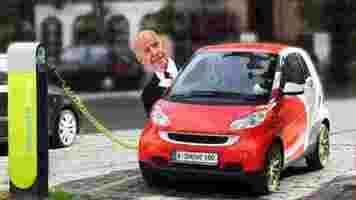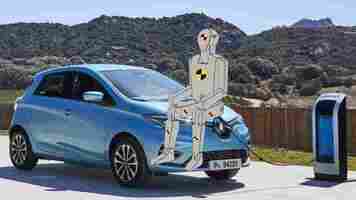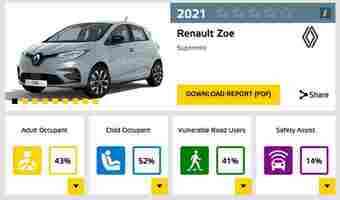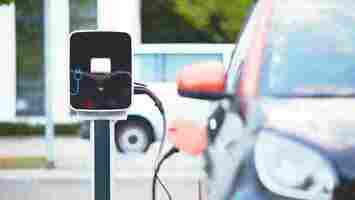The future of US government vehicles is electric
US President Joe Biden has vowed to replace the nation’s government vehicles with an American-made electrically powered fleet, CNBC reports .

The commitment came as part of the “Buy American” executive order, which is designed, as its name suggests, to stimulate government procurement of US-made products.
America’s switch to electric vehicles won’t happen overnight though. It’ll also be quite expensive and challenging because there isn’t a huge amount of choice when it comes to US-made EVs.
Perhaps the most obvious is Tesla, but General Motors and Nissan also produce electric vehicles in the country. Iconic American brand Ford doesn’t make EVs in the States yet, but has announced plans to do so. The blue oval’s Mustang Mach-E is made in Mexico.
Biden hasn’t been too specific about the criteria of what an EV is. In the executive order it simply states that vehicles must have “net zero emissions,” presumably this opens the door for other electrified vehicles such as plug-in hybrids, so long as their gasoline emissions are offset.
The US president hasn’t specified a timeline for when it’s likely to achieve its goal. One thing is for sure, with more than 640,000 vehicles in its fleet , it’s got a mountain climb.
SHIFT is brought to you by Polestar. It’s time to accelerate the shift to sustainable mobility. That is why Polestar combines electric driving with cutting-edge design and thrilling performance. Find out how .
The 2021 Renault Zoe scores a pathetic zero-star safety rating in NCAP crash test
The Renault Zoe may have been Europe’s fourth best-selling EV just a few months ago , but it has seriously failed the latest crash tests by t he European New Car Assessment Programme (NCAP).

In fact, the NCAP ‘awarded’ the 2021 Renault Zoe with zero stars for safety, ironically ruining Renault Laguna’s legacy — the first car to ever receive a five-star rating.


Since its launch in 2013, the Zoe held a five-star safety rating, so this bids the question: what has changed now?
According to Michiel van Ratingen , Secretary General of Euro NCAP, the vehicle’s deficiencies are attributed to a “facelift” introduced in 2020.
The new Zoe received several battery improvements but no added safety. “On the contrary, the seat-mounted side airbag which previously protected head and thorax has been replaced by a less effective thorax-only airbag, representing a degradation in occupant protection,” van Ratingen explains.
The Zoe was also penalized for not having active safety features like automated emergency braking and lane departure warning as standard.
Its poor protection in crashes overall, its poor vulnerable road user protection, and the lack of meaningful crash avoidance technology, are the reasons why it gets disqualified for any stars, van Ratingen concludes.
First up, the EV performed poorly in the frontal offset crash test, offering, according to the NCAP, “weak protection” to the driver’s chest area and to the children’s neck in the backseat.
The Zoe performed even worse in the side pole test, which simulates hitting a tree or lamppost side-on. In fact, the pole struck the test dummy’s head.
You can watch parts of the crash test in the following video — I warn you, it’s pretty scary.
Call me suspicious, but the 2021 Dacia Spring (yes, Dacia is Renault’s sub-brand) has also come up short in NCAP’s crash test, scoring an almost equally bad one-star safety rating.
And I’m not the only one connecting the dots. Van Ratingen remarks:
Well, that’s quite a blow and interestingly Renault did provide comments on the Zoe’s poor rating. The automaker said the following to Autocar :
There’s one point on which I agree with Renault. Every few years the NCAP updates its crash tests employing new technologies and raising the safety standards.
For instance, if an X model passes a test with flying colors in 2013, it might very well fail to succeed in improved tests some years later. But this is not the case here.
We’re talking about conscious equipment alterations and the lack of basic features, vital for safety during the event of accident.
So even if the NCAP crash test process isn’t mandatory for a vehicle’s safety certification (manufacturers voluntarily test their cars or the test body itself buys vehicles to test), it’s still a clear indication of the Zoe’s shortcomings.
EU wants 30 million EVs on the road by 2030 to meet emissions targets
This article was originally published by Christopher Carey on Cities Today , the leading news platform on urban mobility and innovation, reaching an international audience of city leaders. For the latest updates follow Cities Today on Twitter , Facebook , LinkedIn , Instagram , and YouTube , or sign up for Cities Today News.

The European Union wants at least 30 million electric vehicles (EVs) on its roads by 2030, a draft report set to be published this week has revealed.
According to the report, seen by Reuters, other ambitious measures to tackle EU greenhouse gas emissions – 25 percent of which come from the transport sector – are also expected to be laid out.
‘The EU’s goal of climate neutrality by 2050 cannot be reached without introducing very ambitious measures to reduce transport’s reliance on fossil fuels,” the document said, with estimates that the bloc will need three million public charging points and 1,000 hydrogen refueling stations by 2030. This is substantially more than the current 200,000 EV charging points and 1.8 million electric and plug-in hybrid vehicles registered in Europe (EU and non-EU member states) today.
The proposals come amid growing tension among EU members over a plan to toughen the 2030 emissions-reduction target to at least 55 percent by the end of the next decade, from 1990 levels. Raising that goal from the existing 40 percent is a key element of the European Green Deal and would require more spending on energy production and infrastructure.
Last month, the UK – which is currently in transition talks over its withdrawal from the EU – announced it would bring forward the ban on new petrol and diesel cars to 2030, following the example of Sweden, Germany, and the Netherlands.
Infrastructure expansion
To facilitate the switch to zero-emission vehicles, the first of more than 100 planned electric forecourts across the UK was launched by energy firm Gridserve in Essex today as part of a £1 billion (US$1.33 billion) five-year plan.
The solar-powered super-fast electric forecourt will deliver 350kW of charging power – enough to add 200 miles of driving range in 20 minutes – to up to 36 cars at a time.
Toddington Harper, Gridserve’s Founder and Chief Executive, said: “It’s our collective responsibility to prevent greenhouse gas emissions from rising further, and electric vehicles powered by clean energy represent a large part of the solution.
“However, charging has to be simple and free of anxiety, which is why we’ve designed our electric forecourts entirely around the needs of drivers, updating the traditional petrol station model for a net-zero carbon world and delivering the confidence people need to make the switch to electric transport today.”
While Norway leads the way with EV ownership per capita in Europe, thanks to generous tax incentives that drastically reduce the price of EVs, other European countries have had mixed results.
Besides the comparatively high costs of new vehicles, other factors like ‘range anxiety’ – concerns about not being able to find charging facilities – have led to a reluctance among motorists to make the switch.
SHIFT is brought to you by Polestar. It’s time to accelerate the shift to sustainable mobility. That is why Polestar combines electric driving with cutting-edge design and thrilling performance. Find out how .